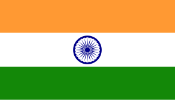
Southeast Asia is the geographical south-eastern region of Asia, consisting of the regions that are situated south of China, east of the Indian subcontinent, and north-west of mainland Australia which is part of Oceania. Southeast Asia is bordered to the north by East Asia, to the west by South Asia and the Bay of Bengal, to the east by Oceania and the Pacific Ocean, and to the south by Australia and the Indian Ocean. Apart from the British Indian Ocean Territory and two out of 26 atolls of Maldives in South Asia, Maritime Southeast Asia is the only other subregion of Asia that lies partly within the Southern Hemisphere. Mainland Southeast Asia is entirely in the Northern Hemisphere. East Timor and the southern portion of Indonesia are the parts of Southeast Asia that lie south of the Equator.

The history of Southeast Asia covers the people of Southeast Asia from prehistory to the present in two distinct sub-regions: Mainland Southeast Asia and Maritime Southeast Asia. Mainland Southeast Asia comprises Cambodia, Laos, Myanmar, Peninsular Malaysia, Thailand and Vietnam whereas Maritime Southeast Asia comprises Brunei, Cocos (Keeling) Islands, Christmas Island, East Malaysia, East Timor, Indonesia, Philippines and Singapore.

The Silk Road was a network of Eurasian trade routes active from the second century BCE until the mid-15th century. Spanning over 6,400 kilometers, it played a central role in facilitating economic, cultural, political, and religious interactions between the East and West. The name "Silk Road", first coined in the late 19th century, has fallen into disuse among some modern historians in favor of Silk Routes, on the grounds that it more accurately describes the intricate web of land and sea routes connecting Central, East, South, Southeast, and West Asia as well as East Africa and Southern Europe.

A trade route is a logistical network identified as a series of pathways and stoppages used for the commercial transport of cargo. The term can also be used to refer to trade over bodies of water. Allowing goods to reach distant markets, a single trade route contains long-distance arteries, which may further be connected to smaller networks of commercial and noncommercial transportation routes. Among notable trade routes was the Amber Road, which served as a dependable network for long-distance trade. Maritime trade along the Spice Route became prominent during the Middle Ages, when nations resorted to military means for control of this influential route. During the Middle Ages, organizations such as the Hanseatic League, aimed at protecting interests of the merchants and trade became increasingly prominent.

Maritime Southeast Asia comprises the countries of Brunei, Indonesia, Malaysia, the Philippines, Singapore, and East Timor.
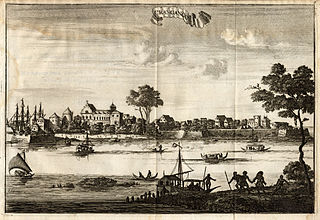
Kodungallur is a historically significant town situated on the banks of river Periyar on the Malabar Coast in Thrissur district of Kerala, India. It is 29 kilometres (18 mi) north of Kochi (Cochin) by National Highway 66 and 38 km (24 mi) from Thrissur. Kodungallur, being a port city at the northern end of the Kerala lagoons, was a strategic entry point for the naval fleets to the extensive Kerala backwaters. It was here that one of Jesus's disciples, St. Thomas reached during 1st century AD to preach Christianity.

The Indian Ocean Rim Association (IORA), formerly known as the Indian Ocean Rim Initiative (IORI) and the Indian Ocean Rim Association for Regional Cooperation (IOR-ARC), is an international organisation consisting of 23 states bordering the Indian Ocean. The IORA is a regional forum, tripartite in nature, bringing together representatives of Government, Business and Academia, for promoting co-operation and closer interaction among them. It is based on the principles of for strengthening Economic Cooperation particularly on Trade Facilitation and Investment, Promotion as well as Social Development of the region. The Coordinating Secretariat of IORA is located at Ebene, Mauritius.
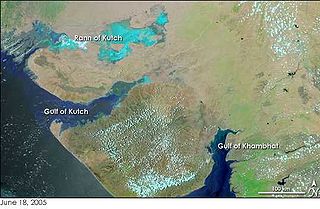
Indian maritime history begins during the 3rd millennium BCE when inhabitants of the Indus Valley initiated maritime trading contact with Mesopotamia. As per Vedic records, Indian traders and merchants traded with the far east and Arabia. During the Maurya Empire, there was a definite "naval department" to supervise the ships and trade. At the end of 1st century BCE Indian products reached the Romans during the rule of Augustus, and the Roman historian Strabo mentions an increase in Roman trade with India following the Roman annexation of Egypt. As trade between India and the Greco-Roman world increased, spices became the main import from India to the Western world, bypassing silk and other commodities. Indians were present in Alexandria while Christian and Jewish settlers from Rome continued to live in India long after the fall of the Roman Empire, which resulted in Rome's loss of the Red Sea ports, previously used to secure trade with India by the Greco-Roman world since the Ptolemaic dynasty. The Indian commercial connection with Southeast Asia proved vital to the merchants of Arabia and Persia during the 7th–8th century. A study published in 2013 found that some 11 percent of Australian Aboriginal DNA is of Indian origin and suggests these immigrants arrived about 4,000 years ago, possibly at the same time dingoes first arrived in Australia.
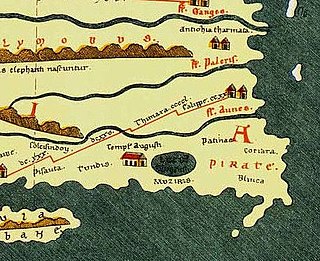
Muchiri, commonly anglicized as Muziris was an ancient harbour and an urban centre on the Malabar Coast. Muziris found mention in the Periplus of the Erythraean Sea, the bardic Tamil poems and a number of classical sources. It was the major ancient port city of Cheras. Core of the city situated in the present day North Paravoor area. The exact location of Muziris has been a matter of dispute among historians and archaeologists. However, excavations since 2004 at Pattanam, near North Paravur, have led some experts to suggesting the hypothesis that the city was located just there. It was an important trading port for Christian and Muslim merchants arriving from other countries.
Indians in the United Arab Emirates constitute the largest part of the population of the country. Over 3,860,000 Indian expats are estimated to be living in the UAE, which is over 38 percent of the total population of the UAE and the fourth highest number of overseas Indian people in the world, after the United States, Saudi Arabia and Nepal. Indian contact with the emirates that now constitute the UAE dates back several centuries, as a result of trade and commerce between the emirates and India. The UAE has experienced a tremendous increase in the population of resident Indians who initially migrated to the country as a result of opportunities in petroleum. Now, Indians are key to the UAE's construction, retail, financial services, healthcare, manufacturing and transport sectors. A sizeable minority of Indian migrants are involved in professional services and entrepreneurship. Relations between India and the UAE have traditionally been very friendly.

India–Myanmar relations, also knows as Indian–Burmese relations or Indian–Myanmar relations, are the bilateral relations between the Republic of India and the Republic of the Union of Myanmar. These relations encompass the political, economic and socio-cultural relations that exist between the two neighboring Asian countries. Political relations have improved considerably since 1993, overcoming tensions related to drug trafficking, the suppression of democracy and the rule of the military junta in Myanmar. Political leaders from both countries meet regularly on a bilateral basis and within the ASEAN Plus Six community. Economic relations are considerable with India representing Myanmar's 4th largest export market and the country's 5th largest import partner.

India and Maldives are neighbours sharing a maritime border. Relations have been friendly and close in strategic, economic and military cooperation. India continues to contribute to maintaining security as well as providing financial aid on the island nation.
The String of Pearls is a geopolitical hypothesis proposed by United States political researchers in 2004. The term refers to the network of Chinese military and commercial facilities and relationships along its sea lines of communication, which extend from the Chinese mainland to Port Sudan in the Horn of Africa. The sea lines run through several major maritime choke points such as the Strait of Mandeb, the Strait of Malacca, the Strait of Hormuz, and the Lombok Strait as well as other strategic maritime centres in Somalia and the littoral South Asian countries of Pakistan, Sri Lanka, Bangladesh, and the Maldives.
Africa–India relations are the historical, political, economic, and cultural connections between India and the African continent.
Indian Ocean trade has been a key factor in East–West exchanges throughout history. Long-distance trade in dhows and proas made it a dynamic zone of interaction between peoples, cultures, and civilizations stretching from Southeast Asia to East and Southeast Africa and East Mediterranean in the West in prehistoric and early historic periods. Cities and states on the Indian Ocean rim focused on both the sea and the land.

Diplomatic relations between the People's Republic of China and the Maldives were established in 1972. China has an embassy in Malé which opened in November 2011, and the Maldives has an embassy in Beijing which opened in 2009. Approximately 70 percent of the Maldives' total debt is attributed to Chinese projects, with an annual payment of $92 million to China, constituting around 10 percent of the country's entire budget. China has become pervasive in the Maldives, exerting influence over infrastructure, trade, and energy sectors, raising concerns of a new form of Chinese entrapment.
The foreign policy of the Modi government is associated with the policy initiatives made towards other states by the current government of India after Narendra Modi assumed the office of prime minister on May 26, 2014.
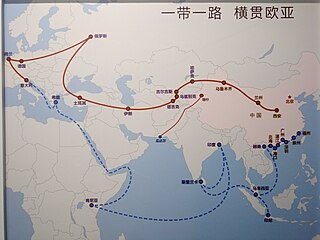
The 21st Century Maritime Silk Road, commonly just Maritime Silk Road (MSR), is the sea route part of the Belt and Road Initiative which is a Chinese strategic initiative to increase investment and foster collaboration across the historic Silk Road.

The Belt and Road Initiative, known within China as the One Belt One Road or OBOR/1B1R for short, sometimes referred to as the New Silk Road, is a global infrastructure development strategy adopted by the Chinese government in 2013 to invest in more than 150 countries and international organizations. It is considered a centerpiece of the Chinese leader Xi Jinping's foreign policy. The BRI forms a central component of Xi's "Major Country Diplomacy" strategy, which calls for China to assume a greater leadership role for global affairs in accordance with its rising power and status. It has been compared to the American Marshall Plan. As of August 2023, 155 countries were listed as having signed up to the BRI. The participating countries include almost 75% of the world's population and account for more than half of the world's GDP.

The Maritime Silk Road or Maritime Silk Route is the maritime section of the historic Silk Road that connected China, Southeast Asia, the Indian subcontinent, the Arabian peninsula, Somalia, Egypt and Europe. It began by the 2nd century BCE and flourished later on until the 15th century CE. Major players in the Maritime Silk Road include the merchants from the Tang, Song, Yuan and Ming dynasties of imperial China, Austronesian sailors in Southeast Asia, Tamil merchants in India and Southeast Asia, and Persian and Arab traders in the Arabian Sea and beyond. The network followed the footsteps of older maritime networks in Southeast Asia, as well as the maritime spice networks of Southeast Asia, Sri Lanka, India, and the Indian Ocean, coinciding with these ancient maritime trade roads by the current era.
